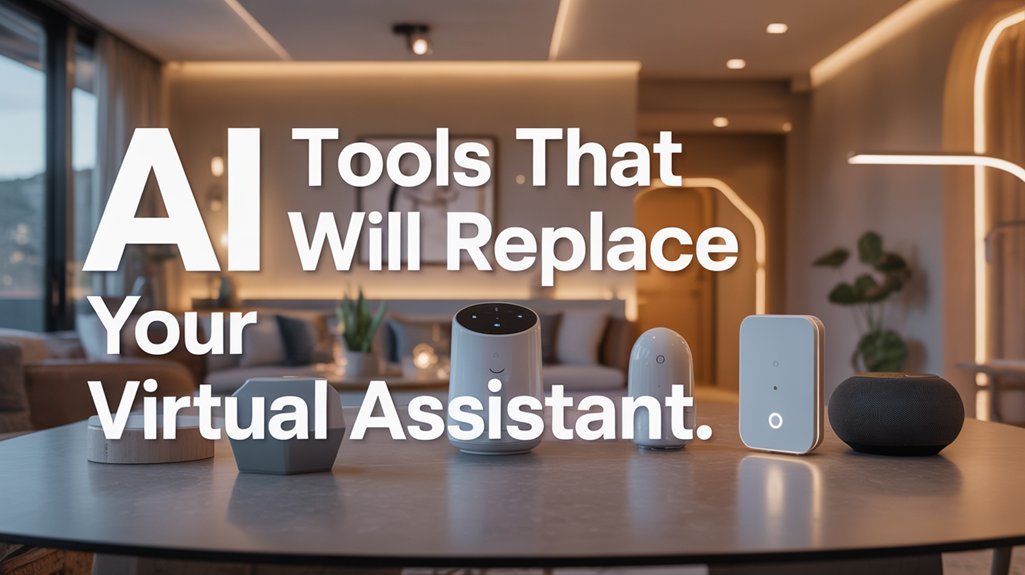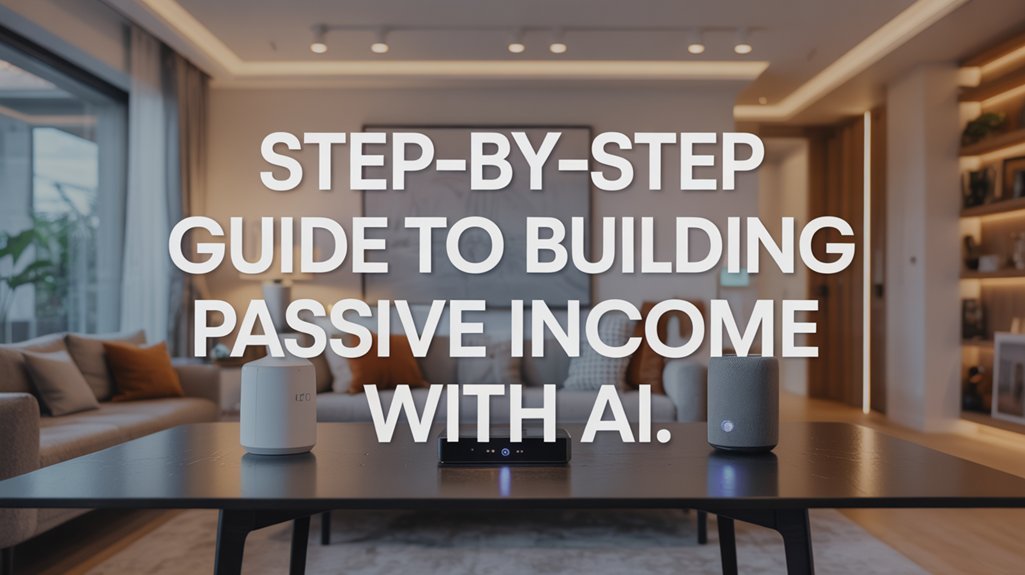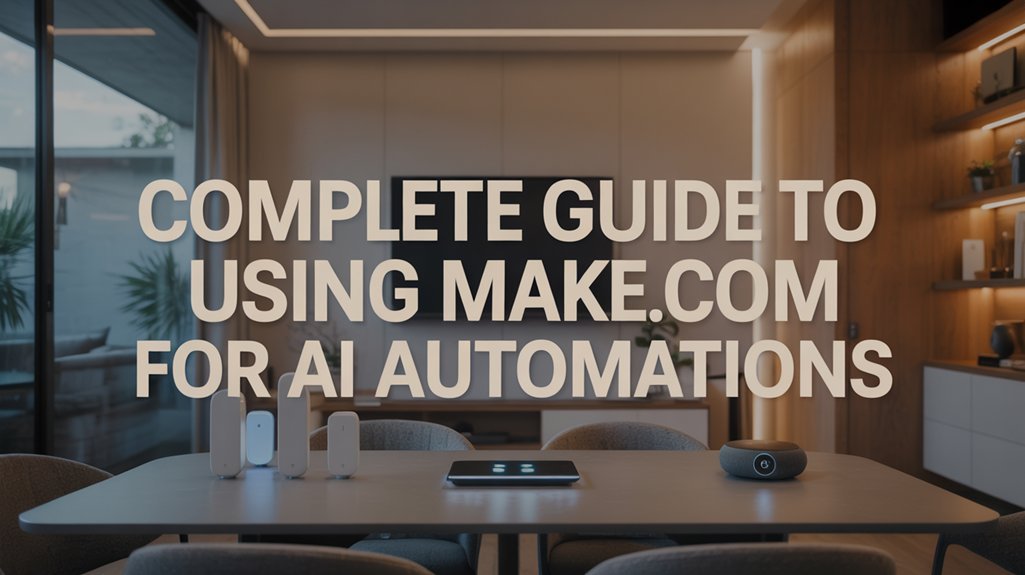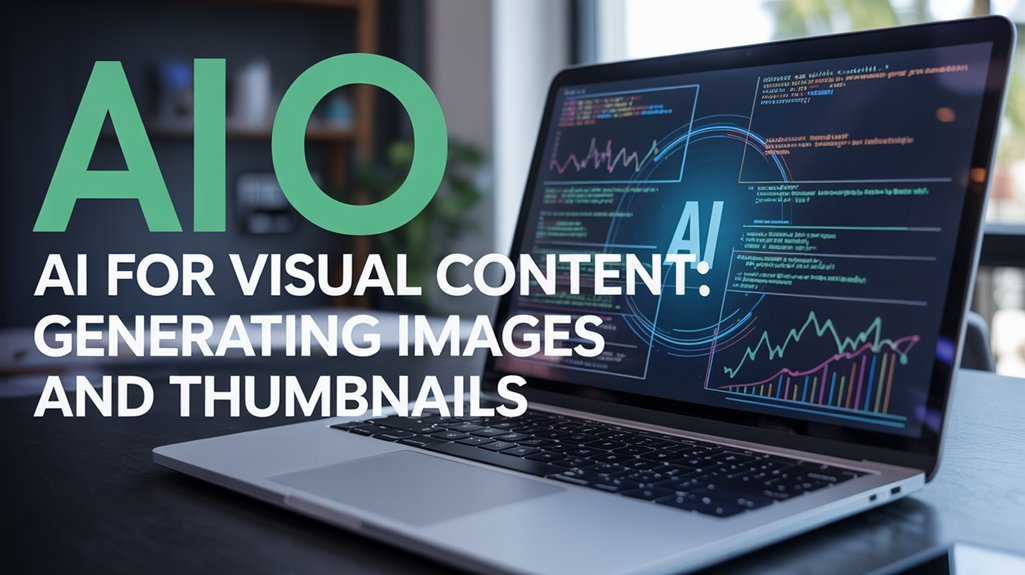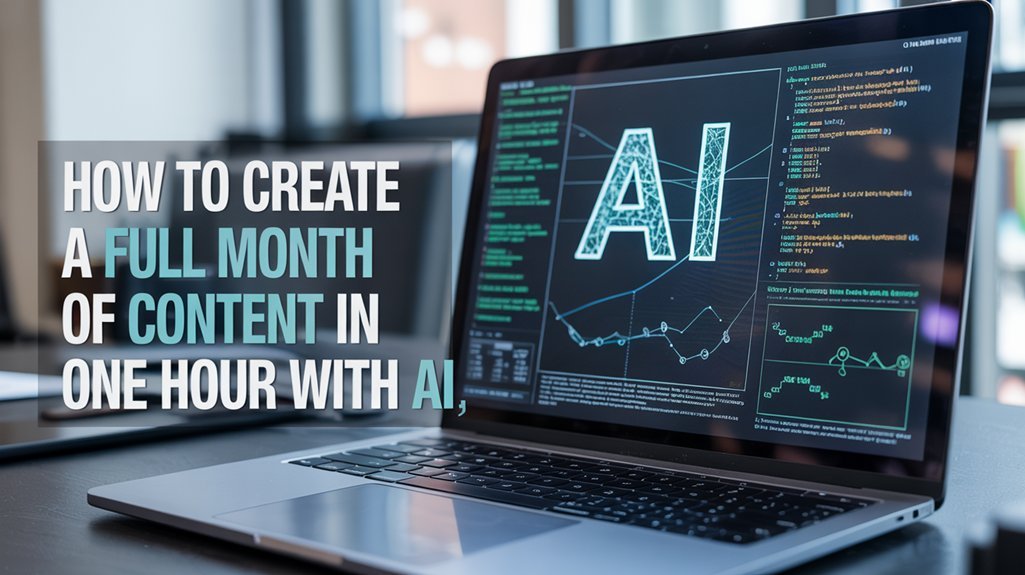AI tools now handle 80% of traditional VA tasks at 5% of the cost through specialized platforms. ChatGPT and GrammarlyGO eliminate repetitive writing workflows, while Otter.ai captures meeting intelligence automatically. Motion reclaims 15 weekly hours through predictive scheduling, and Beautiful.ai converts raw data into executive presentations in minutes. Zapier connects 5,000+ applications to automate routine processes that previously required human oversight. The strategic question isn't whether AI can replace your VA—it's identifying which specific workflows justify maintaining human delegation costs versus algorithmic execution that scales without proportional expense increases.
Key Takeaways
- AI writing tools like ChatGPT reduce content creation costs by 60-80% while generating contextually precise text aligned with business objectives.
- Meeting transcription platforms convert dialogue to searchable text in real-time, reclaiming 67% of post-meeting review time previously spent manually.
- AI calendar tools like Motion reclaim 15 productive hours weekly through auto-scheduling, eliminating the need for expensive virtual assistant coordination.
- Document creation AI automates formatting and design decisions, reducing presentation preparation time by up to 70% with professional-grade templates.
- Workflow automation tools handle repetitive processes across 5,000+ applications, cutting administrative overhead and redirecting hours toward strategic initiatives.
Writing and Communication AI Tools
While traditional virtual assistants once handled routine correspondence and document preparation, AI-powered writing tools now deliver these capabilities at a fraction of the cost—often reducing content creation expenses by 60-80% while maintaining professional quality.
Tools like ChatGPT and GrammarlyGO function as your AI personal assistant, enabling you to generate text that's contextually precise and strategically aligned with your objectives.
These communication AI platforms analyze tone, audience interactions, and messaging hierarchies to improve content creation beyond simple grammar correction.
You'll optimize ROI by deploying reusable prompts for recurring communication needs—investor updates, client proposals, team directives—eliminating repetitive drafting cycles.
The strategic advantage lies in cross-platform integration: your writing content flows effortlessly across email, documentation systems, and collaboration tools without workflow disruption.
This isn't about replacing human judgment; it's about amplifying your capacity to execute high-value communications while delegating mechanical writing tasks to systems that operate at machine speed and human comprehension.
Modern AI writing and optimization suites consolidate these capabilities into unified platforms, streamlining your entire content workflow from ideation to final delivery.
Meeting Transcription and Summarization AI Tools
Because meetings consume 15-35% of organizational bandwidth yet produce fragmented notes and missed action items, AI transcription platforms like Otter.ai and Fireflies.ai deliver quantifiable efficiency gains by changing dialogue to searchable text while extracting decision points in real-time.
These AI tools automatically integrate with your video conferencing infrastructure, eliminating manual recording workflows. You'll capture complete meeting transcription while the system identifies actionable items and surfaces critical decision patterns. Summarization occurs within minutes post-meeting, compressing hour-long discussions into strategic briefings.
AI transcription eliminates manual workflows, delivering searchable meeting intelligence and strategic briefings within minutes of conversation completion.
The productivity multiplier is decisive:
- Reclaim 67% of post-meeting review time previously wasted deciphering fragmented notes
- Zero missed commitments through automated action item extraction and assignment tracking
- Instant knowledge transfer to absent stakeholders without scheduling redundant briefings
- Pattern recognition across meetings revealing recurring bottlenecks and resource constraints
- Searchable institutional memory changing ephemeral discussions into permanent competitive intelligence
You're not delegating transcription—you're architecting systematic accountability that changes meeting overhead into useful strategic assets. By implementing AI note-taking solutions, organizations revolutionize how they capture and operationalize meeting intelligence for sustained competitive advantage.
Calendar and Scheduling AI Tools

AI-powered calendar tools eliminate the $4,000+ monthly cost of a virtual assistant while delivering superior scheduling optimization through machine learning algorithms.
Motion's intelligent auto-scheduling engine fluidly reorganizes your task queue based on priority weights and deadline constraints, reclaiming an average of 15 productive hours per week.
You'll achieve measurable ROI through Reclaim's automated team coordination that reduces meeting conflicts by 67% and Clockwise's focus time optimization that increases deep work blocks by 4+ hours weekly per employee.
These calendar automation solutions represent a broader shift toward AI workflow automation that transforms how teams manage their daily operations and resource allocation.
Motion's Intelligent Auto-Scheduling
Manual calendar management costs knowledge workers an average of 4.5 hours per week—time that translates directly to lost productivity and revenue.
Motion's AI eliminates this inefficiency through intelligent auto-scheduling that analyzes your calendar and task management priorities simultaneously. The platform's algorithms automatically detect conflicts, allocate ideal time blocks for deep work, and reorganize your schedule as priorities shift.
Strategic advantages that consolidate executive control:
- Reclaim 234+ hours annually previously wasted on manual scheduling coordination
- AI-driven conflict resolution prevents double-bookings before they impact client relationships
- Real-time calendar synchronization eliminates version control issues across platforms
- Automated project management integration surfaces critical deadlines without manual tracking
- Intelligent task prioritization guarantees revenue-generating activities receive protected time blocks
You'll automate tasks that drain strategic thinking capacity while maintaining complete visibility across concurrent initiatives. By mastering time management with AI tools, executives can redirect their focus from administrative overhead to strategic decision-making that drives business growth.
Reclaim for Team Coordination
While Motion improves individual scheduling efficiency, distributed teams face a compounding challenge: coordinating availability across multiple stakeholders without sacrificing individual productivity.
Reclaim's smart algorithms solve this through AI-powered automation that analyzes individual habits, priorities, and recurring task blocks across your entire team. This scheduling tool doesn't just find open slots—it identifies ideal meeting windows that protect focus time and respect personal routines.
The platform's integration with Slack, Zoom, and Asana changes team coordination from reactive calendar Tetris into proactive workflow orchestration. AI helps you visualize real-time team availability while automatically adjusting schedules as priorities shift.
For leaders seeking quantifiable returns, Reclaim delivers improved time management through reduced scheduling conflicts and preserved deep work blocks, directly impacting output velocity and resource utilization across your organization.
Clockwise's Focus Time Optimization
Beyond simply finding meeting slots, Clockwise fundamentally restructures how calendars consume your team's cognitive resources. Its AI features automatically defragment schedules, creating consolidated focus time blocks that enhance deep work productivity.
You'll gain strategic control over calendar management through intelligent rearrangement that adapts as priorities shift, protecting your team's most valuable asset: uninterrupted thinking time.
The ROI manifests through measurable efficiency gains:
- Eliminate scheduling friction with conversational AI that books meetings without derailing your workflow
- Reclaim 20% more focus time through algorithmic calendar optimization across your entire organization
- Reduce coordination overhead using Scheduling Links that automatically protect focus time preferences
- Accelerate decision velocity by ensuring critical meetings happen without fragmenting productive hours
- Scale team efficiency through flexible meetings that intelligently prioritize deep work over calendar Tetris
Document and Presentation Creation AI Tools

You're losing billable hours when your team manually formats documents and redesigns presentations from scratch.
AI-powered document generators and smart presentation design tools eliminate these productivity drains by automating layout decisions and template applications, reducing document creation time by up to 70%.
AI-Powered Document Generators
The traditional document creation process drains productivity through manual formatting, template hunting, and design iteration—activities that generate zero strategic value.
AI document generators eliminate this bottleneck, allowing you to generate content with strategic precision while maintaining your personal touch.
Tools like Beautiful.ai and Canva deploy intelligent automation that converts raw input into executive-grade deliverables.
You'll work faster by offloading design decisions to algorithms trained on thousands of professional templates.
These platforms are easy to use, yet deliver sophisticated customization that adapts to your brand parameters.
Strategic advantages you'll command:
- Reclaim billable hours previously lost to formatting warfare
- Enforce brand consistency across all organizational touchpoints
- Eliminate design bottlenecks that delay critical communications
- Scale document production without scaling headcount
- Integrate workflows across your existing productivity infrastructure
Smart Presentation Design Tools
While document generators handle static deliverables, presentations demand lively visual storytelling that converts stakeholders and closes deals.
Smart presentation design tools like Beautiful.ai and Canva eliminate the bottleneck of slide formatting, deploying AI-powered templates that adapt to your content automatically. You'll gain hours back as automated layout suggestions enhance visual hierarchy without manual intervention, letting you focus on strategic messaging rather than pixel-pushing.
Real-time collaboration features accelerate iteration cycles, enabling teams to incorporate executive feedback instantly. These platforms integrate smoothly with PowerPoint and Google Slides, preserving your existing workflows while upgrading output quality.
The ROI is measurable: you'll produce professional presentations in a fraction of traditional timeframes, freeing your capacity for revenue-generating activities that demand human judgment and persuasion.
Automated Formatting and Templates
Formatting friction drains thousands of hours annually from knowledge workers who wrestle with inconsistent layouts, misaligned elements, and brand guideline violations across documents and decks.
Automated formatting through AI tools like Beautiful.ai, Canva, and Tome eliminates this productivity tax. These platforms deploy intelligent templates that adapt to your content while enforcing brand standards, altering document creation from a design exercise into a strategic deliverable.
Strategic advantages you'll command:
- Reclaim 40+ hours monthly previously lost to manual formatting adjustments
- Enforce brand consistency across all materials without policing every document
- Scale content production without proportionally scaling headcount
- Respond to market opportunities faster with instantly-deployable templates
- Redirect cognitive resources from design mechanics to strategic messaging that drives revenue
Your competitive edge depends on velocity. These AI tools deliver it.
Task and Workflow Automation AI Tools

As organizations scale their operations, task and workflow automation AI tools have emerged as critical infrastructure for eliminating productivity bottlenecks. Platforms like Zapier and Notion AI deliver measurable ROI by automating repetitive processes across 5,000+ integrated applications, eliminating manual data entry that drains strategic capacity.
You'll reduce context switching and accelerate execution velocity through automated workflows that trigger actions based on predetermined conditions—sending reminders, updating databases, and generating reports without human intervention.
AI-driven automation alters your task management infrastructure by analyzing routine operations and implementing intelligent triggers that execute flawlessly. This systematic approach minimizes human error while delivering consistent, reliable outcomes across your entire operation.
The financial impact is substantial: you'll cut administrative overhead costs by reducing dependency on additional human resources for time-consuming tasks. Your team redirects reclaimed hours toward high-value strategic initiatives that drive competitive advantage.
Task and workflow automation isn't optional—it's fundamental infrastructure for organizations demanding operational excellence and measurable productivity gains.
Research and Data Analysis AI Tools
Workflow automation generates immediate productivity gains, but your competitive advantage depends on converting information into strategic intelligence at scale.
Research and data analysis AI tools eliminate the bottleneck between raw information and executive decision-making. These systems execute thorough data analysis in seconds, delivering predictive analytics that position you ahead of market shifts.
Modern AI tools change your operational capability through:
- Automated data preparation that reclaims hours previously lost to manual cleaning and validation
- Real-time source verification through platforms like Perplexity AI, ensuring your decisions rest on current intelligence
- Predictive analytics engines that forecast trends before competitors identify opportunities
- Visual intelligence platforms like Tableau AI that convert complex datasets into immediate strategic insights
- Algorithmic research synthesis that processes volumes no human team could match
You're not delegating research—you're deploying superior analytical firepower.
The automation of intelligence gathering doesn't replace judgment; it amplifies your strategic reach exponentially.
Frequently Asked Questions
Will Virtual Assistants Be Replaced by AI?
You won't see complete replacement—you'll witness change.
AI capabilities will automate 45% of routine VA tasks, reshaping the job market toward strategic roles.
Automation trends indicate you'll enhance ROI by deploying AI for repetitive work while leveraging VAs' human touch for high-stakes relationship management and complex decision-making.
Future predictions show you'll gain competitive advantage through hybrid models: AI handles efficiency, while skilled VAs drive revenue-generating activities requiring emotional intelligence and nuanced judgment you can't automate.
Which AI Tool Is Best for Personal Assistants?
The best AI tool depends on your battlefield:
Motion wins for thorough workflow optimization through intelligent task automation, delivering peak personal efficiency.
Reclaim dominates for managers seeking team-level digital organization with habit tracking.
Clockwise excels at protecting focus time through meeting optimization.
Each tool's AI capabilities directly impact ROI differently—Motion enhances individual output, Reclaim scales management efficiency, and Clockwise preserves your team's deep work capacity.
Choose based on your primary productivity bottleneck.
Can AI Be My Virtual Assistant?
Yes, AI can serve as your virtual assistant, delivering strong task automation and personal productivity gains.
When evaluating virtual assistant comparison metrics, AI capabilities now handle scheduling, communication, and data analysis with impressive AI reliability. You'll achieve measurable ROI through reduced overhead costs and 24/7 availability.
However, strategically assess which functions demand human judgment versus algorithmic efficiency. AI excels at repetitive workflows, but complex stakeholder management may still require human nuance for maximum power retention.
What's the Best AI Virtual Assistant?
The best AI virtual assistant depends on your power requirements.
Motion delivers superior task automation with intelligent scheduling that optimizes ROI through predictive prioritization.
Reclaim excels at team-level integration options, syncing across enterprise platforms.
Your choice hinges on cost comparison: Motion's $34/month suits individual executives, while Reclaim's team pricing scales strategically.
Evaluate best features against your workflow complexity—user experience matters less than quantifiable productivity gains.
You'll achieve 40% time savings with proper implementation.
Conclusion
You're standing at automation's crossroads, where AI tools aren't just sharpening your competitive edge—they're fundamentally restructuring your operational economics. Each virtual assistant function you automate translates directly into recovered capital and reallocated human intelligence toward revenue-generating activities. The question isn't whether these tools will displace traditional VAs; it's how quickly you'll quantify the productivity multiplier and integrate them before your competitors do. Your ROI clock's already ticking.

